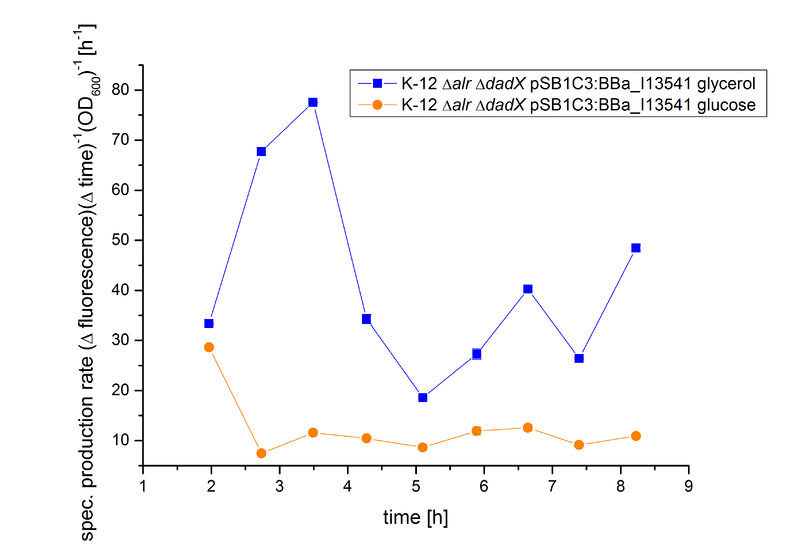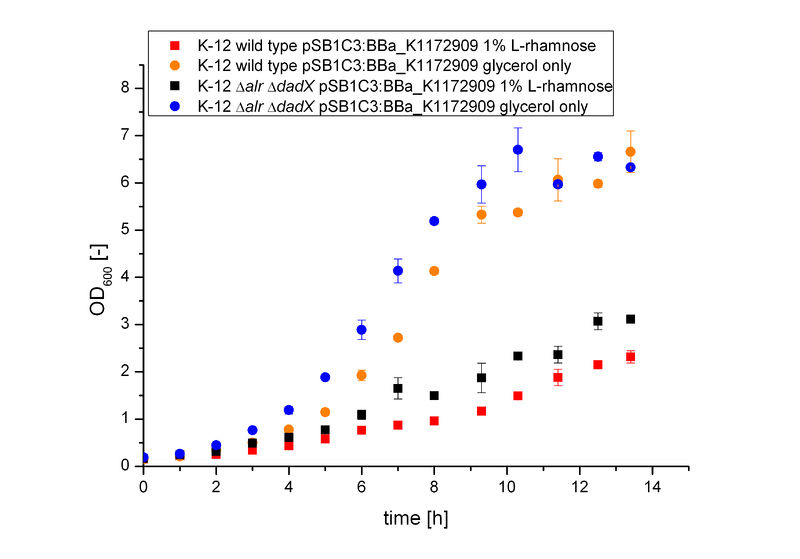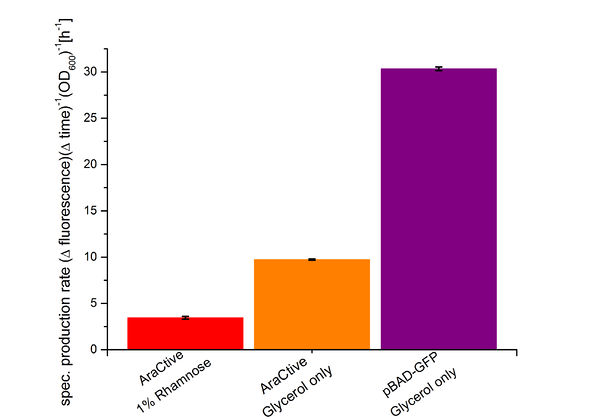Part:BBa_K1172906
Part 2 of the Biosafety-System araCtive (pBAD Barnase)
Usage and Biology
These biobrick is an improvement of the Biobrick BBa_K914014 by changing:
- the promoter to obtain a lower basal transcription.
- the Alanine-Racemase (alr) for gaining higher plasmid stability and for taking advantage of the double-kill switch.
- changing the repressor to araC for higer repression and lower basal transcription of the second part.
Sequence and Features
- 10COMPATIBLE WITH RFC[10]
- 12COMPATIBLE WITH RFC[12]
- 21COMPATIBLE WITH RFC[21]
- 23COMPATIBLE WITH RFC[23]
- 25COMPATIBLE WITH RFC[25]
- 1000COMPATIBLE WITH RFC[1000]
Results
Characterization of the arabinose promoter pBAD
First of all the bacterial growth under the pressure of the unrepressed pBAD promoter was investigated on different carbon source. Therefore the cultivation on M9 minimal media with Glucose or Glycerol was characterized. To identify the transcription rate of the unrepressed arabionse promoter pBAD the expression of the green fluorescence protein GFP BBa_E0040 behind the pBAD promoter was used.
As shown in figure 12 below, the bacteria adapted better on glucose then on Glycerol. As glucose is the more powerful energy source, because it posses more carbon atoms than glycerol these result was expected before. So more interesting are the fluorescence measurement shown in the figure 13. As it can be seen both the wild type K-12 as the Biosafety-Strain K-12 ∆alr ∆dadX ∆araC show about the same fluorescence on glucose (blue and black curve) but differ on glycerin. This can be explained by the fact that glucose itself also represses the arabinose promoter, while glycerol does not. In the presence of glucose the intracellular concentration of cAMP is low to repress the inefficient catabolism of arabinose, so that the glucose is catabolized first by the bacteria resulting in an optimal growth. In the absence of glucose increases, which enhances the transcription of the most operons, who regulate the enzymes for the catabolism of an alternative carbon source. Therefore the expression of GFP under the control of the pBAD promoter decreases on glycerol. Another different can be seen between the wild type (orange curve) and the Biosafety-Strain K-12 ∆alr ∆dadX ∆araC (red curve). The Biosafety-Strain shows lower expression then the wild type, but has according to figure 12 about the same growth rate. This is caused by the fact that the araC gene in the Biosafety-Strain was deleted an as the araC gene functions not only as are repressor but also as an activator the transcription rate decreases.


The effect that glucose represses the transcription of the pBAD promoter becomes more clear by the specific production rate, as shown in figure 14. The specific production rate was thereby calculated via equation (1) :
Characterization of the Biosafety-System araCtive
The Biosafety-System araCtive was characterized on M9 minimal medium with glycerol as carbon source. As for the characterization of the pure arabinose promoter pBAD above, the bacterial growth and the fluorescence of GFP BBa-E0040 was measured. Therefore the wild type and the Biosafety-Strain E. coli K-12 ∆alr ∆dadX were cultivated once with the induction of 1% L-Rhamnose and once only on glycerol.
First of all it is obviously shown in figure 15 that the growth of the bacteria, who are induced with 1 % L-Rhamnose (blue and black curve) is significant slower than on pure glycerol (orange and red curve). This is attributed to the high metabolic pressure of the induced bacteria. The expression of the repressor araC and the Alanine-Racemase (alr) simultaneously causes a high outlay of the cells so that they grow slower then the uninduced cells, who expresses only GFP. Additional the arabinose promoter pBAD is tightly regulated, so that the expression even with a small amount of the repressor AraC is not that high and therefore not as stressful.
Comparing the bacterial growth with the fluorescence in figure 16 it can be seen that the fluorescence seems to follow the same figure than the bacterial growth. The uninduced cells shows approximately an exponantial rise of fluorescence, while the fluorescence of the induced bacteria increases only slow.
From the figure above it can not be seen if the expression of the repressor araC does effect the transcription of GFP or not. The slower growth of the bacteria is a first indication that the repressor araC and the Alanine-Racemase are highly expressed, but as the growth of the bacteria shows nearly the same figure than the fluorescence it could be possible that the repressor does not effect the expression level of GFP under the control of the arabinose promoter pBAD. That the Biosafety-System works as aspected by repressing the expression of GFP in the presence of L-Rhamnose can be seen from figure 18 below. The calculated specific production rate (equation 1) differs clearly, so that the production of GFP in the presence of L-Rhamnose is always lower than in its absence.
As the specific production rate was calculated between every single measurement point the curve is not smoothed and so the fluctuations have to be ignored, as they do not stand for are real fluctuations in the transcription in the expression of GFP. They are caused by the growth curve and the fluorescence curve. And this measured curves are not ideal the calculation of the specific production rate causes the fluctuations. But it can be seen very clear that the production of GFP differ an is much lower, when the bacteria are induced with 1% L-Rhamnose. So the Biosafety-System araCtive works.
Conclusion of the Results
As the expression level of GFP is increased in the absence of L-Rhamnose and decreased in its presence, the Biosafety-System araCtive works as aspected. In figure 18 the specific production rates after 7,5 hours are compared. It can be seen that the expression level of the pBAD promoter decreases in the uninduced Safety-Strain compared to the uninduced second part of the Biosafety-System and that the induction with L-Rhamnose leads to a tight repression of the transcription and therefore the expression of GFP.
References
- Baldoma L and Aguilar J (1988) Metabolism of L-Fucose and L-Rhamnose in Escherichia coli: Aerobic-Anaerobic Regulation of L-Lactaldehyde Dissimilation [http://www.ncbi.nlm.nih.gov/pmc/articles/PMC210658/pdf/jbacter00179-0434.pdf|Journal of Bacteriology 170: 416 - 421.].
- Carafa, Yves d'Aubenton Brody, Edward and Claude (1990) Thermest Prediction of Rho-independent Escherichia coli Transcription Terminators - A Statistical Analysis of their RNA Stem-Loop Structures [http://ac.els-cdn.com/S0022283699800059/1-s2.0-S0022283699800059-main.pdf?_tid=ede07e2a-2a92-11e3-b889-00000aab0f6c&acdnat=1380629809_2d1a59e395fc69c8608ab8b5aea842f7|Journal of molecular biology 216: 835 - 858].
- Cass, Laura G. and Wilcoy, Gary (1988) Novel Activation of araC Expression and a DNA Site Required for araC Autoregulation in Escherichia coli B/r [http://www.ncbi.nlm.nih.gov/pmc/articles/PMC211425/pdf/jbacter00187-0394.pdf|Journal of Bacteriology 170: 4174 - 4180].
- Hamilton, Eileen P. and Lee, Nancy (1988) Three binding sites for AraC protein are required for autoregulation of araC in Escherichia coli [http://www.ncbi.nlm.nih.gov/pmc/articles/PMC279856/pdf/pnas00258-0029.pdf|Proc Natl Acad Sci U S A 85: 1749 - 53].
- Mossakowska, Danuta E. Nyberg, Kerstin and Fersht, Alan R. (1989) Kinetic Characterization of the Recombinant Ribonuclease from Bacillus amyloliquefaciens (Barnase) and Investigation of Key Residues in Catalysis by Site-Directed Mutagenesis [http://pubs.acs.org/doi/pdf/10.1021/bi00435a033|Biochemistry 28: 3843 - 3850.].
- Paddon, C. J. Vasantha, N. and Hartley, R. W. (1989) Translation and Processing of Bacillus amyloliquefaciens Extracellular Rnase [http://www.ncbi.nlm.nih.gov/pmc/articles/PMC209718/pdf/jbacter00168-0575.pdf|Journal of Bacteriology 171: 1185 - 1187.].
- Schleif, Robert (2010) AraC protein, regulation of the L-arabinose operon in Escherichia coli, and the light switch mechanism of AraC action [http://gene.bio.jhu.edu/Ourspdf/127.pdf|FEMS microbial reviews 34: 779 - 796.].
- Voss, Carsten Lindau, Dennis and Flaschel, Erwin (2006) Production of Recombinant RNase Ba and Its Application in Downstream Processing of Plasmid DNA for Pharmaceutical Use [http://onlinelibrary.wiley.com/doi/10.1021/bp050417e/pdf|Biotechnology Progress 22: 737 - 744.].
- Walsh, Christopher (1989) Enzymes in the D-alanine branch of bacterial cell wall peptidoglycan assembly. [http://www.jbc.org/content/264/5/2393.long|Journal of biological chemistry 264: 2393 - 2396.]
- Wickstrum, J.R., Santangelo, T.J., and Egan, S.M. (2005) Cyclic AMP receptor protein and RhaR synergistically activate transcription from the L-rhamnose-responsive rhaSR promoter in Escherichia coli. [http://www.ncbi.nlm.nih.gov/pmc/articles/PMC1251584/?report=reader|Journal of Bacteriology 187: 6708 – 6719.].
| None |






